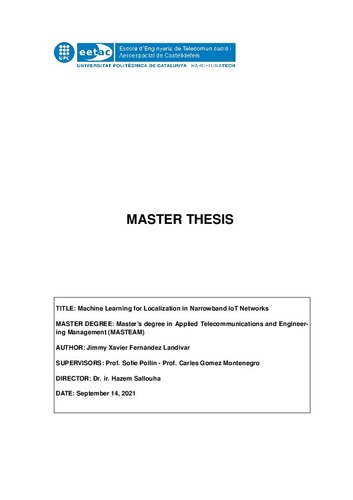Mostra el registre d'ítem simple
Machine learning for localization in narrowband IoT networks
| dc.contributor | Gómez Montenegro, Carlos |
| dc.contributor | Pollin, Sofie |
| dc.contributor | Sallouha, Hazem |
| dc.contributor.author | Fernández Landivar, Jimmy Xavier |
| dc.contributor.other | Universitat Politècnica de Catalunya. Departament d'Enginyeria Telemàtica |
| dc.date.accessioned | 2021-09-30T10:37:58Z |
| dc.date.available | 2022-10-01T00:26:39Z |
| dc.date.issued | 2021-09-24 |
| dc.identifier.uri | http://hdl.handle.net/2117/352737 |
| dc.description.abstract | Low power wide area networks (LPWANs) are designed for Internet of Things (IoT) appli- cations because of their long-range coverage, low bit rate, and low battery consumption. In the LPWAN networks, Narrow-band IoT (NB-IoT) is a type of network that uses the licensed cellular spectrum, working over the deployed LTE infrastructure. It is rising as a promising technology because of its characteristics and deployment advantages against other LPWAN networks. In NB-IoT networks, localization is an essential service for applications such as smart cities, traffic control, logistics tracking, and others. The outdoor localization is often performed using a Global Navigation Satellite System (GNSS) like Global Positioning System (GPS) to send the current device position with some meters accuracy. However, due to GPS¿s power and size drawbacks, recent reports focus on alternatives to replace GPS-based localization systems with cost and power efficient solutions. This work analyses a database collected over an NB-IoT deployed network in the city of Antwerp in Belgium and implements a solution for outdoor localization based on Machine Learning (ML) methods for distance estimation. The data analysis starts in the pre-processing step, where the databases are cleaned and prepared for the ML analysis. The following process merges and debugs the data to obtain an integrated database with classification for urban and rural areas. The localization solution performs a support vector regression, random forest regression, and a multi-layer perceptron regression using as input parameters the received signal strength indicator (RSSI) and the base station (BS) position details in order to predict the distance to the IoT nodes and estimate the current position (latitude and longitude) of them. This implementation includes hyper-parameter tuning, the train and test process, and mathematical calculations to obtain the estimated position with mean and median location estimation errors expressed in meters. The implementation of the methodology processes results in 280 and 220 meters corre- sponding to the mean and median location errors for the urban area and 920 and 570 meters for the rural area. The accuracy levels obtained in the results turn this solution suitable for the most common uses of localization in IoT instead of using a GPS device. As a result, this study proposes a new approach for localization in IoT networks. In addition to the implemented solution defines valuable research lines to improve the accuracy levels and generate more contributions to optimize the equipment resources and reduce the IoT device¿s final cost. |
| dc.language.iso | eng |
| dc.publisher | Universitat Politècnica de Catalunya |
| dc.rights.uri | http://creativecommons.org/licenses/by-nc-sa/3.0/es/ |
| dc.subject | Àrees temàtiques de la UPC::Enginyeria de la telecomunicació |
| dc.subject.lcsh | Internet of things |
| dc.subject.lcsh | Machine learning |
| dc.subject.other | LPWAN |
| dc.subject.other | IoT |
| dc.subject.other | NB-IoT |
| dc.subject.other | Machine Learning |
| dc.subject.other | Localization |
| dc.title | Machine learning for localization in narrowband IoT networks |
| dc.type | Master thesis |
| dc.subject.lemac | Internet de les coses |
| dc.subject.lemac | Aprenentatge automàtic |
| dc.identifier.slug | PRISMA-160393 |
| dc.rights.access | Open Access |
| dc.date.updated | 2021-09-28T03:30:43Z |
| dc.audience.educationlevel | Grau |
| dc.audience.mediator | Escola d'Enginyeria de Telecomunicació i Aeroespacial de Castelldefels |
| dc.audience.degree | MÀSTER UNIVERSITARI EN APLICACIONS I GESTIÓ DE L'ENGINYERIA DE TELECOMUNICACIÓ (MASTEAM) (Pla 2015) |
| dc.audience.degree | Mobilitat outgoing |
| dc.contributor.covenantee | Katholieke Universiteit te Leuven |
| dc.description.mobility | Outgoing |
| dc.description.mobility | Outgoing |
| dc.description.sdg | Objectius de Desenvolupament Sostenible::9 - Indústria, Innovació i Infraestructura |
| dc.description.sdg | Objectius de Desenvolupament Sostenible::11 - Ciutats i Comunitats Sostenibles |


